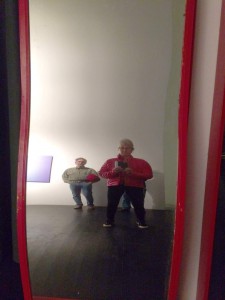Myopia: a retrospective of a Devo founder Oct. 30, 2014 - April 12, 2015

Denver – The tickets for the opening gala or members preview were as pricey as a walk-up lift ticket, so we waited until all the hoopla was over to see the show Myopia at the Contemporary. I expected the show to be a marketing ploy for Mark Mothersbaugh to sell more prints and drawings in galleries like other big-name artists who come to Denver and are sponsored by their gallery. And, good or not, his work is likely to be sellable since Mothersbaugh is a celebrity (I’m sure Facebook and Wikipedia allow him to say that) because he was one of the creators of Devo, an art band with similarities to the Talking Heads.
Surprise. This exhibition was not museum-level marketing for salable artwork. It was a retrospective of a life spent making art in many arenas, most of which is not very tangible.
I listened to Devo in the 1970s and I appreciate that they were a comic foil for the super seriousness of art. The super serious feeling that overcomes you when you go to see a musical work by John Cage, say something called 4′33″. There is no sound, and etiquette requires that one sits and experiences it.
After you’ve heard it once, you have to laugh. And while I enormously appreciate the idea of manipulating music, abstracting it, so far that it is silence, I want a laugh. Pop art became that chuckle, comic books and graffiti are continuing it. But starting in the late 1970s, the Vietnam War over, music took on a seriousness of simplicity – punk. A seriousness of honesty and non-commercialism that was a follow up to the father of punk, Lou Reed. Your narrative of this evolution of our culture is probably different, but however you explain it there is value in Devo being that comic persona with a serious progressive message.
When Devo was being played, we were not at cotillion. We laughed. We danced and dressed in silly ways and didn’t expect that someone would say we were moving incorrectly. Or even being filmed looking willowy and sensual at Woodstock. We were being silly. And were happy to do so because recent history had sucked – wars for bad reasons, Nixon the Crook, the Warren Report. After 1976, and goodbye Gerald Ford, things seemed like they were going to turn out great. We’d solve all the dirty water and air problems and were ready to run everything off solar power. Devo spoofed the fear of science that had hobbled our parents, and we were ready to go full steam ahead into the future.

One of my companions in viewing this show was more of a Devo devotee than I, and loved what a few others of our group complained was nostalgic. I was fascinated by the nostalgia too, particularly a film about the shooting at Kent State in 1970. All the members of Devo went to college at Kent, and one apparently witnessed the shooting. I can remember the names of Crosby, Stills, Nash and Young, but couldn’t have told you the name of one of the four victims of the shooting. This film was about one of them, a Ms. Krauss, whose first name I want to say is Allison, but this recollection makes me realized how mind altered I am by celebrity and mass marketing.
Mothersbaugh’s work makes fun of mass marketing (as Pop Art did also) and includes a lot of collage, specifically pasting in notebooks or on postcards, pasting – immortalizing – things from the existing consumer culture. It is flippant, or as one friend said – smug – mockery of the stuff, but at the heart of it, I see an attempt to find clarity.
And as the Devo-devotee pointed out, the work and Devo rose out of the Kent State Massacre with the warning: “There is evil out there and it doesn’t look like what we expect it to be”. The message ‘Look again and look carefully’ was coming from everywhere – philosophy started saying it with structuralism and then more thoroughly with Derrida’s deconstruction to the nth degree.
And as we look back, the evil out there was Ronald Reagan – not the ray gun.
In the 1970s, visual art became a shotgun spray of individual artworkers. As a genre, it became muddled, multi-cultural and multi-medium. To know someone who was a painter and also in a band was not unusual. But it had been before then. During this time, painting was dead (I think Time said something like this). And it was dead because art was attached to the idea of non-commercialization. No need to make it; no need to buy it. Art is random, and so from this came Punk. Make love not war; make art not money. I don’t know Devo’s philosophy about money, but my guess is that it was a joke to them.
It is obvious from our perspective today, that Mothersbaugh has made a bundle of it.

Another of my companions said the show was full of stuff that a rich guy can do with his money. So let me get back to the exhibition.
The rich guy had a car made that has two back ends. This car, a boxy Scion is placed in a gallery that is filled with small photographs that have been duplicated as mirror images, cut and re-assembled in a fan shape so that the eyes are farther apart and the lips compressed (or some other horizontally symmetrical composition). The images are humans, or a few animals, and the symmetry right and left immediately has our eyes reading them as something we need to look in the eyes. The center of this smallish gallery is filled with the (compact) car, which is very subtle, likely expensive and well done. And it works to push us as viewers against the walls to get close to the many mirror images, printed small and placed in antique, keepsake-style frames.

The bigger gallery, upstairs at the MCA, is filled with scrapbooks – all the same size, all holding page after page of postcards on which Mothersbaugh has drawn. The curatorial note tell us that he has been drawing on postcards for his entire artistic life and it is overwhelming to see all of these laid out on the ground. I walked out of the gallery, took a breath, and went back in to flip through some of the pages. You could only flip a few in each book, there was really no place to sit, and barely any to squat.
These images weren’t really meant to be looked through, said Companion 1. They are to show a life’s work. And they made Companion 2 feel bad; she wishes she had made a drawing or several on a postcard everyday of her artistic life. She feels she isn’t disciplined enough. But her work is more time consuming that pasting a scrap on a card and doodling around it. She is painting every detail of the scrap. Whether it’s worth doing or not. She doesn’t want to think it’s not. Companion 1 said, I just keep doing what I’m doing and can’t think about worth. Two very different approaches but both are doing exactly what they learned as artists in the 1970s – life is not about making money.
Mothersbaugh’s doodles and drawings on postcards are just for the doing of it. Eventually something comes out that is useful for something. Acrylic rugs were made from some of the designs. And some plastic figures, too, that are arranged in another gallery as a sculpture installation.
Sound occasionally plays in another gallery. It comes from three machines that electronically go off at intervals. The machines are programmed to create music; labels imply that they are found sounds and that the music is random. The machines are interesting to look at. Imagine an enormous xylophone bent around into a cylinder; horns coming off the top of one machine to amplify the sound of the devices that are its array of notes – the devices make animal calls. Another music maker is more like an old telephone switchboard with bells. The music, however, is too pleasant to be random. It’s good.
Rugs and some posters decorate the walls in this room, but here’s where the rich guy spending his money comes into play, again. The rugs say very little about rugness. They are cartoons someone printed and yes this talks about the art life in our technological age, but makes me think of how celebrity downgrades culture production. More about that later.
A video of the band Devo in performance and some black light posters are on the lower level. The use of the black light separates the mishmash of images that are abundant in the postcards and journals into layers of meaning. It’s an interesting devise – using different lights – to try to clarify all the conflicting stuff thrown in the mix. The posters show it all, but light highlight some bits and then others. To me this is more interesting than picking out a good cartoon and printing it on a rug.
All together – the nostalgia, celebrity band photos, stuff made from very personal drawings and journals into commercial stuff that a rich guy can afford to make – this a very educational exhibition of visual art from the past, like seeing an Impressionist show at the Denver Art Museum. It’s nice to see all of someone’s work in one place and to feel a life in art. However, I don’t see in it an art that speaks to this moment in time.
Which brings out a revelation of how the world could be better – what if someone who really had a vision for creating cartoon drawings on acrylic (floor-mat style) rugs had money and time to devote to fully using this format for artistic expression? Could these rugs have been better if the artist wasn’t scoring films and busy being famous and choosing work because it was on one of his postcards? If more artists were free (had the time and money) to make soemething would it be a better piece of communication, better art?
And to my companions at the MCA, all of them, let’s keep making stuff whether we’re famous or not, and maybe we’ll come up with something great to be seen or experienced, that speaks to the moment of time, or more importantly to the people in those moments when they see or experience it.

